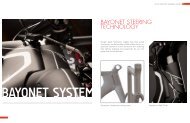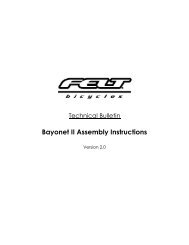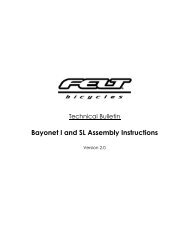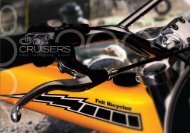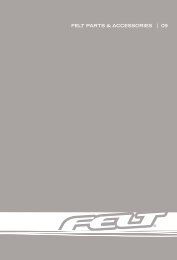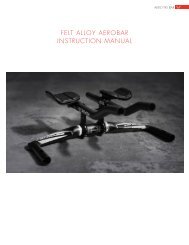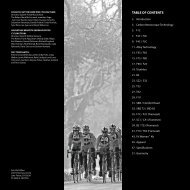Bicycle Owners Manual - Felt Bicycles
Bicycle Owners Manual - Felt Bicycles
Bicycle Owners Manual - Felt Bicycles
You also want an ePaper? Increase the reach of your titles
YUMPU automatically turns print PDFs into web optimized ePapers that Google loves.
• SIGNIFICANT SCRATCHES, GOUGES, DENTS<br />
OR SCORING CREATE STARTING POINTS FOR<br />
CRACKS. Think about the cut surface as a focal point<br />
for stress (in fact engineers call such areas “stress risers,”<br />
areas where the stress is increased). Perhaps you<br />
have seen glass cut Recall how the glass was scored<br />
and then broke on the scored line.<br />
• SOME CRACKS (particularly larger ones) MAY MAKE<br />
CREAKING NOISE AS YOU RIDE. Think about such a<br />
noise as a serious warning signal. Note that a wellmaintained<br />
bicycle will be very quiet and free of creaks<br />
and squeaks.<br />
SIMPLE RULE 4 : Do not<br />
scratch, gouge or score any<br />
surface. If you do, pay frequent<br />
attention to this area or<br />
replace the part.<br />
SIMPLE RULE 5 : Investigate<br />
and find the source of<br />
any noise. It may not a be a<br />
crack, but whatever is causing<br />
the noise should be fixed<br />
promptly.<br />
WARNING: Do not ride a bicycle or component with any crack, bulge<br />
or dent, even a small one. Riding a cracked frame, fork or component<br />
could lead to complete failure, with risk of serious injury or death.<br />
B. Understanding composites<br />
All riders must understand a fundamental reality of composites. Composite<br />
materials constructed of carbon fibers are strong and light, but when crashed or<br />
overloaded, carbon fibers do not bend, they break.<br />
<strong>Felt</strong> Carbon Fiber Frame Care: Many <strong>Felt</strong> bicycles feature a carbon-fiber frame.<br />
Such frames require special care. To learn more, please refer to the special<br />
warning card included in the box with your bicycle or visit: http://www.feltbicycles.<br />
com.<br />
In most cases a fatigue crack is not a defect. It is a sign that the part has been<br />
worn out, a sign the part has reached the end of its useful life. When your car<br />
tires wear down to the point that the tread bars are contacting the road, those<br />
tires are not defective. Those tires are worn out and the tread bar says “time for<br />
replacement.” When a metal part shows a fatigue crack, it is worn out. The crack<br />
says “time for replacement.”<br />
Fatigue Is Not A Perfectly Predictable Science<br />
Fatigue is not a perfectly predictable science, but here are some general<br />
factors to help you and your dealer determine how often your bicycle should be<br />
inspected. The more you fit the “shorten product life” profile, the more frequent<br />
your need to inspect. The more you fit the “lengthen product life” profile, the less<br />
frequent your need to inspect.<br />
Factors that shorten product life:<br />
Hard, harsh riding style<br />
“Hits”, crashes, jumps, other “shots” to the bike<br />
High mileage<br />
Higher body weight<br />
Stronger, more fit, more aggressive rider<br />
Corrosive environment (wet, salt air, winter road salt, accumulated<br />
sweat)<br />
Presence of abrasive mud, dirt, sand, soil in riding environment<br />
Factors that lengthen product life:<br />
Smooth, fluid riding style<br />
No “hits”, crashes, jumps, other “shots” to the bike<br />
Low mileage<br />
Lower body weight<br />
Less aggressive rider<br />
Non-corrosive environment (dry, salt-free air)<br />
Clean riding environment<br />
What Are Composites<br />
The term “composites” refers to the fact that a part or parts are made up of<br />
different components or materials. You’ve heard the term “carbon fiber bike.” This<br />
really means “composite bike.”<br />
Carbon fiber composites are typically a strong, light fiber in a matrix of plastic,<br />
molded to form a shape. Carbon composites are light relative to metals. Steel<br />
weighs 7.8 grams/cm 3 (grams per cubic centimeter), titanium 4.5 grams/cm 3 ,<br />
aluminum 2.75 grams/cm 3 . Contrast these numbers with carbon fiber composite<br />
at 1.45 grams/cm 3 .<br />
The composites with the best strength-to-weight ratios are made of carbon<br />
fiber in a matrix of epoxy plastic. The epoxy matrix bonds the carbon fibers<br />
together, transfers load to other fibers, and provides a smooth outer surface. The<br />
carbon fibers are the “skeleton” that carries the load.<br />
Why Are Composites Used<br />
Unlike metals, which have uniform properties in all directions (engineers call<br />
this isotropic), carbon fibers can be placed in specific orientations to optimize<br />
the structure for particular loads. The choice of where to place the carbon fibers<br />
gives engineers a powerful tool to create strong, light bicycles. Engineers may<br />
also orient fibers to suit other goals such as comfort and vibration damping.<br />
Carbon fiber composites are very corrosion resistant, much more so than most<br />
metals.<br />
Think about carbon fiber or fiberglass boats.<br />
Carbon fiber materials have a very high strength-to-weight ratio.<br />
What Are The Limits Of Composites<br />
Well designed “composite” or carbon fiber bicycles and components have long<br />
fatigue lives, usually better than their metal equivalents.<br />
While fatigue life is an advantage of carbon fiber, you must still regularly<br />
inspect your carbon fiber frame, fork, or components.<br />
Carbon fiber composites are not ductile. Once a carbon structure is<br />
overloaded, it will not bend; it will break. At and near the break, there will be<br />
rough, sharp edges and maybe delamination of carbon fiber or carbon fiber fabric<br />
layers. There will be no bending, buckling, or stretching.<br />
44 45




